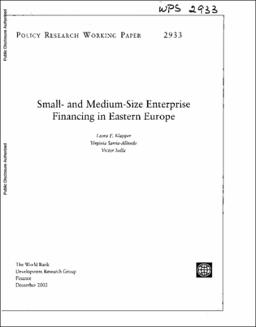| dc.description.abstract | There is currently a large interest in understanding firms' percentage of total employment) in Eastern European
access to finance, particularly in the financing of small- countries is smaller than in most developed economies.
and medium-size enterprises (SMEs). But the financing Although the authors find in almost every country in the
patterns of SMEs across countries is not well understood. sample a large number of SMEs as a percentage of total
For example, little is known about the relative firms, the SMEs in Eastern Europe are generally small
importance of equity, debt, and inter-firm financing for and hire few employees. However, SMEs seem to
SMEs across countries. constitute the most dynamic sector of the Eastern
The authors use the Amadeus database, which includes European economies, relative to large firms. In general,
financial information on over 97,000 private and the SME sector comprises relatively younger, more
publicly traded firms in 15 Eastern and Central European highly leveraged, and more profitable and faster growing
countries. The Amadeus database allows the authors the firms. This suggests that a new type of firm is emerging
opportunity to provide a new analysis of the general in transition economies that is more market- and profitfinancing
patterns of private firms across a large sample oriented. But at the same time, these firms appear to
of Eastern European countries. The summary statistics have financial constraints that impede their access to
show that the size of the SME sector (as measured by the long-term financing and ability to grow.access to finance, particularly in the financing of small- countries is smaller than in most developed economies.
and medium-size enterprises (SMEs). But the financing Although the authors find in almost every country in the
patterns of SMEs across countries is not well understood. sample a large number of SMEs as a percentage of total
For example, little is known about the relative firms, the SMEs in Eastern Europe are generally small
importance of equity, debt, and inter-firm financing for and hire few employees. However, SMEs seem to
SMEs across countries. constitute the most dynamic sector of the Eastern
The authors use the Amadeus database, which includes European economies, relative to large firms. In general,
financial information on over 97,000 private and the SME sector comprises relatively younger, more
publicly traded firms in 15 Eastern and Central European highly leveraged, and more profitable and faster growing
countries. The Amadeus database allows the authors the firms. This suggests that a new type of firm is emerging
opportunity to provide a new analysis of the general in transition economies that is more market- and profitfinancing
patterns of private firms across a large sample oriented. But at the same time, these firms appear to
of Eastern European countries. The summary statistics have financial constraints that impede their access to
show that the size of the SME sector (as measured by the long-term financing and ability to grow. | en_US |


